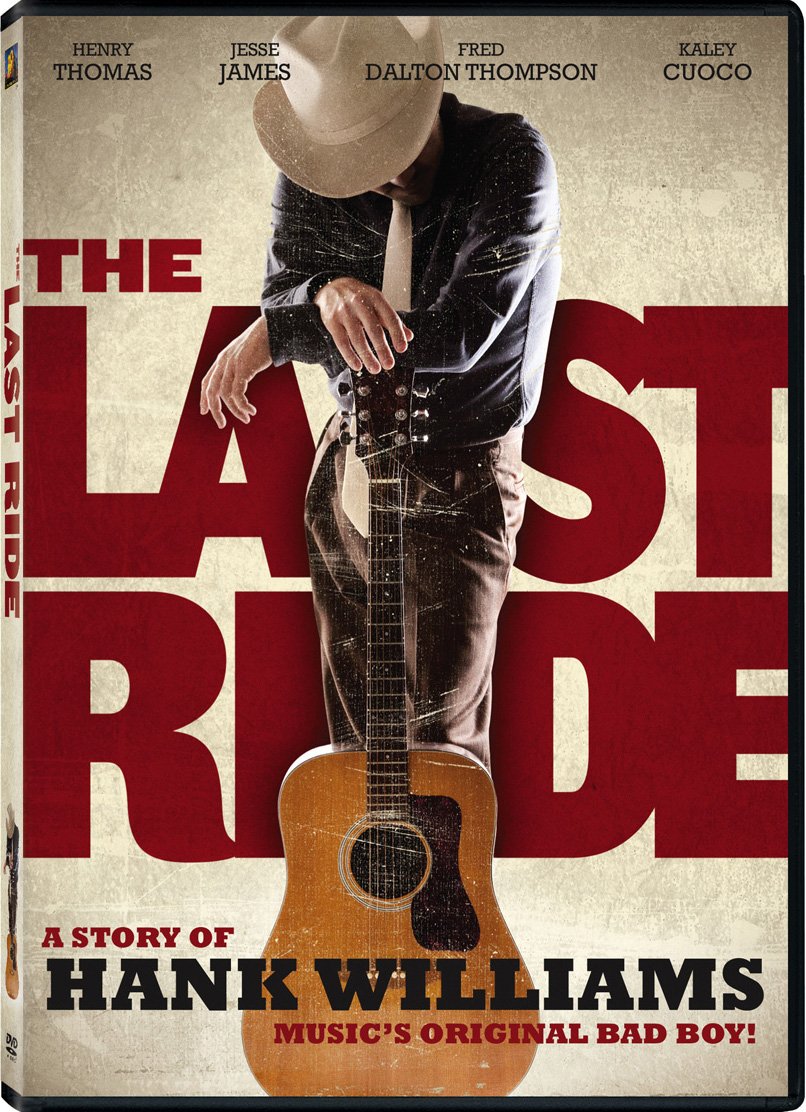
The Last Ride is the debut of Bill Gaither’s son Benjy as a film producer. Though he neither directed the movie nor wrote the script for it, he is credited as “executive producer, producer” on IMDB and wrote all the original music for the film, including several new songs. The movie is a fictionalized look at the last days of country music superstar Hank Williams, who died tragically at age 29 from substance abuse and health issues related to the birth defect of spina bifida. After becoming a country music legend in an amazingly short time, Williams let both his personal life and his career disintegrate. In 1952, he attempted to stage two back-to-back comeback shows scheduled over New Years’ in West Virginia and Ohio. A heavy ice storm ruled out flight, so Williams hired a college student to drive him. This also failed because of the ice storm. While some details of Williams’ road trip remain a mystery, we know that he died some time on News Years’ Day, 1953.
This film imaginatively fleshes out those details, but viewers should be aware that much of it is simply made up, and unfortunately some of the fiction collides with the fact we do know. Nevertheless, I was moved by this film and would recommend it to viewers looking for a compelling human story. Here is my full review.
Pros
1. The two leads

Although Jesse James is younger and doesn’t loom as large in the screen as the more experienced Thomas, he brings refreshing sincerity to the role of Silas. While Thomas plays the fading legend, James makes the film work believably well as a coming-of-age story for his character (even though his half of the story is all fiction save for the fact that the actual driver was also a college freshman). He starts off as a shy, earnest youth, eager to please and completely ignorant of who his famous passenger is. He’s never owned a radio and never cared for music. All he knows is that he’s being paid to get the mysterious stranger known as “Mr. Wells” (or “Luke,” another alias Hank gives him as the relationship thaws) to Charleston, West Virginia sober and on time.
Silas is unable to say no to virtually anything the dictator in the back seat demands. He even breaks the law twice by following Williams’s demands to pass cars on the highway. (The second time, he gets caught, and a justice of the peace points out to Silas that no matter how persuasive “Mr. Wells” may have been, Silas was the responsible adult in charge of the car and Williams wasn’t threatening him—this time.) One could argue that his innocence is sometimes played up too much, but it’s used to powerful and poignant effect in quiet scenes where Williams begins to soften toward the boy, recognizing that here is someone he can trust implicitly. The lad also reveals a quick temper when Williams is being assaulted and beaten up in a bar, rushing to his defense and savagely lighting into the attacker. While much of the script simply calls for James to stare at the road and look worried, he still manages to show us different sides of the boy who’s becoming a man.
(For an interview with Henry Thomas about preparing for the role, click here. I also read a different interview which contained the fascinating information that he and James shot all the car scenes in a single day in front of a green screen. That’s talent for you!)
2. The directing
Harry Thomason’s smart directing gets the most out of the movie’s small budget. He brings a deft touch to both small and big scenes. For example, the movie’s first sequence introduces us to Silas’s thankless job as a grease monkey for an unreasonable taskmaster. As he struggles underneath one of the cars, oil begins dripping onto his face. Silas squints and squirms, unable to stop the flow and muttering curses. It’s a simple scene, but the viewer really feels Silas’s discomfort. In another scene, Silas has made a short trip alone in Hank’s car and begins to shut the door as he climbs back in. But instead of the slamming sound the viewer expects to hear, the scene cuts immediately to the crashing sound of broken glass as Hank is sucker-punched through the door back at the bar. It’s not a new kind of trick, but it’s an effective one.
Two of the film’s most moving moments are entirely visual. As the car is stopped in front of a drugstore in one scene, Williams glances out the window to see a group of young boys experimenting with alcohol and cigarettes. One of the boys looks up and guiltily makes eye contact with the singer, who’s watching quietly from the back seat as he fights a bout of coughing and nausea. In a scene toward the very end of the film, Silas has stopped at a church to borrow a scraper, again leaving Williams alone in the back seat. A woman and her child walk out of the church, and the little girl pauses in front of the iced-over windshield to look at the strange man in the cowboy hat. As he looks up, he sees her toothless grin through the glass and smiles faintly. This scene works especially well because we know from a previous scene that Williams had an affair with a woman who is about to give birth to his daughter. In that scene, he left an envelope full of money with the doctor who would perform the delivery, saying awkwardly that he wanted to “make things right.” (This part of the story is true—Hank Williams did have a daughter, Jett, born out of wedlock five days after his death. She is now a singer, and her voice can be heard on the soundtrack for this film.)
3. The soundtrack
Benjy Gaither’s instrumentals are tasteful and understated, striking exactly the right tone everywhere. The moody modern feel he provides creates a nice contrast with the country/gospel songs that make up the bulk of the soundtrack (among which his originals fit in almost seamlessly). These songs are worked in fairly naturally as Williams is constantly insisting that the car radio be playing. Perhaps the most effective soundtrack moments occur as his death draws closer. The last song they hear on the radio is “Uncloudy Day,” as he sips his coffee and hums along with his eyes closed. And the song being sung inside the church at the end is “Going Home.” As Williams listens outside, he slumps down in the back of his blue Cadillac to sleep for the last time.
Some have commented on the lack of actual Hank Williams performances, but doubtless the copyright fees would just have been too high. However, several of his songs are covered by contemporary gospel artists. Finally, as I’ve mentioned before, I was especially impressed with the original song “The Last Ride,” a powerful reflection on mortality and age and a fitting epitaph for Williams’s life.
Pro-Cons
1. The story
The story is the film’s biggest pro-con to me. On the one hand, there’s certainly a lot of dramatic mileage in the idea of a broken, fading legend who’s given one last couple of days to think over his life before he dies. Like Silas, we’re exasperated with “Luke,” yet we have compassion on him also. He demands our attention. We can’t help being drawn into the story, and we can’t stuff down the lump in our throats when the end inevitably comes. The viewer truly feels the tragedy of Hank Williams. And the ending doesn’t tie anything up in a neat bow. There’s no “Come to Jesus” moment for old Luke. Just the sweet strains of “Going Home,” occasionally broken by a retching cough. Resolving nothing, yet leaving the door just slightly open for hope to shine through the crack.
Furthermore, the idea of placing Hank Williams in a car with a driver who doesn’t know his name is very cool. It makes for a lot of good old-fashioned storytelling as the two men start off as complete strangers and slowly form a real friendship. Williams can hardly believe that the boy really doesn’t know who he is. It takes his ego down a peg as he slowly realizes he can’t buy or impress Silas into becoming his friend. He, the great Hank Williams, is the one with lessons to learn—about loyalty, about trust, about honesty.
There’s also an excellent re-creation of one piece of the journey we do know for a fact. The two men stop at a hotel, where Williams calls his doctor to get “an injection” and then has to be carried unconscious to his car the following morning. The viewer is left to guess what else he might have asked for besides “Vitamin B-12.” (We know in fact that it was morphine.) It’s also a fact that Williams was found to have sustained some kind of a beating during the autopsy, so while the bar brawl is fictionalized, it’s a logical and natural way of explaining the extra trauma found on the body.
But there are problems with the heavily fictionalized angle. The biggest one is that we know the real driver was in fact a long-time friend of the Hank Williams family. So the main premise of the movie is false, even though the basic frame and a few intermediate details are true. Moreover, while the character portrait of Hank Williams is drawn very well, it’s also very romanticized. Even if the driver had been a stranger, it’s doubtful that the real Hank Williams would have been interested in getting to know him or benignly offering him nuggets of worldly advice, as this Hank Williams does. At one point, he gently nudges Silas toward a pretty girl who’s caught his eye (in an innocent way), encouraging him to go back and ask her again for a date after she’s turned him down once. “They always say no the first go-around, but they don’t mean it.” Of course the old salt is proven right. All that is pure Hollywood cheese, and it clashes with the few glimpses we do get into Williams’s darker side.
Of course, this isn’t the first time a movie producer has used some creative license in re-telling a true story. But it’s one thing to change some details. It’s another to write a different story altogether.
2. The script
The script, much like the story, comes off a mite unsteady on its feet, a little unsure of the tone it’s supposed to strike. Parts of it are tight and well-written. After the hotel sequence, Williams wakes up and begins interrogating Silas about the night before. He’s suspicious that the boy might have stolen something while he slept. “I know exactly how much traveling money I brought with me boy.” This touches a nerve with Silas. “I didn’t see no money, ‘cuz I wasn’t looking for no money, sir.” The give and take between the two characters in this scene is tense and convincing.
Other parts of the script feel somewhat forced and cliched. For example, upon learning that Silas has never had a girlfriend, Williams reflects and offers up this original pearl of wisdom: “Ah, you’re probably better off for it. All they do is tear your heart out and then leave you standing there like a damn fool.” Of course he changes his mind later in the love interest sequence, which also suffers from the watery “Hallmark touch.” But then among the cliches, you get a jarring piece of dialogue like this, which occurs when the duo is on the road again after their run-in with the justice of the peace:
Hank: What’s your daddy do?
Silas: [pauses] Time.
Hank: Ohhh. That’s why that old boy back there scared the [expletive] out of you. You scared of that aren’t you? Following in daddy’s footsteps. How about your momma then, what’s she do?
Silas: Don’t want to talk about this.
Hank: My momma ran a whorehouse. Beat that.
Silas: Don’t want to talk about this Mr. Wells. Luke, whatever your name is.
Hank: [chuckles dryly]
And then between the corny and dark elements of the script, you’ve got the occasional sequence that’s a combination of both. In one example that feels like something out of O Brother Where Art Thou, a very drunk Williams forces Silas to pass a swine truck, brandishing a gun to strengthen his case (this is the time when they don’t get caught). As the terrified young driver complies, Hank sticks his head out of the roof and begins raising a hoot and a holler while firing the pistol randomly into the air. And in true Coen Brothers style, this all plays out to the tune of “Keep On the Sunny Side of Life.” Oddly enough, I actually liked the Southern Gothic flavor this scene added to the whole thing, and a part of me wished they’d explored that angle a bit more.
Then there are a few moments of pure gold:
Hank: Turn on the radio.
[Silas complies, and the first thing to come on is a fluffy ditty with whistling and peppy female harmonies.] Hank: Change it.
[Silas changes it again. This time it’s a cover of “The Wabash Cannonball.” The singer is nasal and obnoxious.] Hank: Aw hell, change that.
[Silas changes it again. The song is “It Wasn’t God Who Made Honky-Tonk Angels.” He’s finally found the country station. Tasteful. Simple.] Hank: [sighs, removes his hat, eyes closed] Oh, yessuh.
Cons
1. “Most of… I mean some of what follows is true.”
In the pro-con, I criticized the film’s generous liberties with the facts surrounding Hank Williams’s death. However, this would be less of a problem were it not for a title card that boldly states “Most of what follows is true.” If they were going to have such a disclaimer, a more honest statement would have been “Some of what follows is true.” Or better yet, leave out the disclaimer entirely and let the viewer judge/research for himself what is fact and what is fiction. As it is, the title card just confuses matters.
2. Cussin’
I’m not against all cussing in films, and this one certainly isn’t the worst example of gratuitous foul language I could dream up. The strongest cuss word uttered is the “s-word.” There are no f-bombs and no crude slang for sexual body parts. However, all the “B-level” words are covered. “Damn” and “hell” occur with special frequency. Sometimes, as in the last example I quoted under “script,” this works naturally. Other times I wonder if the scriptwriter was just trying to stuff in an extra swear. Example: They ask a gas station clerk about restaurant options, and when he names one, Hank asks, “Is it any damn good?” Perhaps the idea was to convey authenticity, but sometimes this backfires and actually feels forced. It’s definitely a bad sign when the viewer starts thinking of Spock trying out “colorful metaphors” in The Voyage Home. (“One damn minute, admiral!”) Because the language content is so steady, and because of the other thematic elements in the script, I’d say the PG-13 rating is warranted. But I think it could have been PG without losing much of the impact, and in fact deleting some of the swears would have improved the script.
3. “These aren’t the fans you’re looking for”
While the film was a labor of love designed to appeal to Hank Williams fans, I think based on the reviews I’ve seen that the most ardent Hank purists might not go for it. There’s no Hank singing and almost no Hank songs. Other period songs have also been re-done by contemporary singers, even a few that are heard on the radio. The character of Hank Williams has been softened and embellished for the sake of Hollywood drama. The nature of his “last ride” has been radically altered for the same purposes. While I still enjoyed the film as a good story in its own right, I’m also not a rabid Hank Williams fan. For all these reasons, I fear the movie has been marketed to the wrong fanbase.
Final thoughts: One sign that I’ve watched a good movie is that I feel like I want to see it again after finishing it the first time. This film qualified on that count. It delivered on every emotional level for me. I cried a couple different times, especially at the end. It’s not without its flaws, but considering the resources at the filmmakers’ disposal, I was very impressed. Like I said, I wouldn’t necessarily recommend it to Hank Williams fans, at least not die-hard ones. But if you’re looking for good human interest material with some fine acting and a classy indie feel, this just might be the movie for you.












